
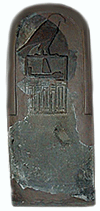
Qa'a stele, found at the tomb of King
Qa'a, First Dynasty (3000-2800 B.C.)
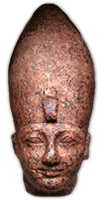
Head of Thutmosis III (E14370), Dynasty
18. He wears the tall, bulbous crown of Upper Egypt with a rearing uraeus
at his brow, symbolizing his royal power.
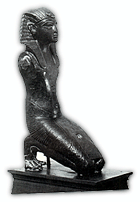
Bronze statuette of Turankhamun (E14295).
It originally had inlays of gold.
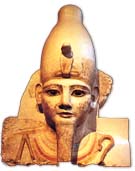
Ramses II (69-29-1) in the guise of Osiris.
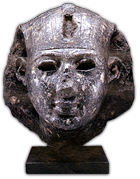
The head of Osorkon II (E16199), Dynasty
22.
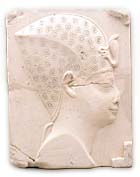
Plaque of a Ptolemaic king (E14315),
Ptolemaic Period (305-30 B.C.)
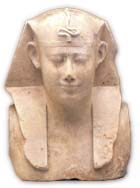
Bust of a Ptolemaic king (E14314), Ptolemaic
Period (305-30 B.C.)
|
One of the defining features of ancient Egyptian civilization
is the tremendous importance of its semi-divine rulers, the pharaohs.
The office of Egyptian kingship was perceived as sacred and the kings
themselves were understood to be intermediaries between mankind and
the gods. The role of pharaoh is most visible in the emphasis placed
on the king in the monumental record. The University of Pennsylvania
Museum's (UPM) Egyptian collection has an outstanding collection of
material relating to kingship and royalty.
Qa'a Stele
Stelae were often set up in pairs in front of the tombs of the earliest
kings of Egypt. King Qa'a, a ruler of the First Dynasty (3000-2800 B.C.)
was buried at the site of Abydos. The stele
depicts the name of the king inside a rectangularly shaped symbol known
as a serekh. The lower part of this rectangle is decorated with
a representation of niched facaded found on royal buildings from this
period. The serekh is surmounted by a falcon representing the god Horus,
a deity associated with the ruling king and his divine office.
Thutmosis III
One of the most powerful kings of the Eighteenth Dynasty (1539-1292
B.C.) was Thutmosis III. He came to the throne as a young child and
during the early part of his reign shared rule of Egypt with his father's
sister-wife, Queen Hatshepsut, who ruled as a pharaoh in her own right.
After her death, Thutmosis III succeeded in becoming on the greatest
pharaohs of the New Kingdom. He expanded the borders of Egypt by conquering
Asia as far as the Tigris-Euphrates valley.
Tutankhamun
Also in the Museum's collections is a small statue of King Tutankhamun
(1333-1323 B.C.). He wears a nemes headdress and kilt. This type
of kneeling statue was often a part of temple equipment and may have
been housed in a sacred barque that was carried in religious processions.
The statue is made of black bronze and certain elements of the piece
were originally decorated with a contrasting gold gilding. Traces of
gilt remain on the king's nipples and headdress. The eyes and eyebrows
may also have been inlaid originally with another precious material.
Akhenaten
The Pharaoh Akhenaten (1353-1335 B.C.) of the 18th Dynasty was responsible
for the religious, artistic, and cultural revolution known as the Amarna
period. Akhenaten raised a single deity, the Aten or sun disk, to the
position of sole god in Egypt, a drastic change from its traditional
polytheistic religion. During this time, artistic and literary styles
underwent similar changes. Two and three dimensional representations
of people are characterized by elongated heads, necks, and limbs; full
breasts, stomachs, hips, and thighs; and slender waists. Scenes of the
royal family replaced those of the traditional deities in temples, tombs,
and private votive contexts. After Akhenaten's death, religious and
artistic traditions were restored.
Ramses II
Ramses II, often called "Ramses the Great," was one of the most
prolific builders in Egyptian history. His productivity was unmatched
in other areas of his life as well: for example, he fathered more than
100 children with his two principal wives, Queens Nefertari and Asetnofret,
along with his many secondary wives. During his 67 year reign (1290-1224
B.C.), Ramses built more monuments to himself than any other pharaoh.
His record of the Battle of Kadesh was recorded in at least eight different
places throughout Egypt. One monumental statue in the UPM's collection
from the site of Abydos depicts the king
in the guise of the great mortuary god Osiris.
The king is shown wearing the white crown and a false beard. He grasps
the crook and the flail, traditional elements of royalty, in his hands.
This statue was originally brightly painted and some of its original
color still remains.
Osorkon II
The pharaoh Osorkon II was the fourth king of the 22nd Dynasty (945-712
B.C.), a series of rulers of Libyan origin that spanned 200 years. During
the early part of the reign of Osorkon II, the country was divided and
Harsiese, the High Priest of Amun in Thebes
declared himself king in the south. After Harsiese's death, Osorkon
II reunited Egypt and set off a major building campaign, including an
impressive hall in the temple of Bastet at
Bubastis. The UPM's head of Osorkon (the body is in the Cairo Museum)
comes from the site of Tanis (the seat of Dynasty 22) and was originally
part of a kneeling figure of the king.
The identity of some of the kings in the Museum's collection
are not certain. The style of the portraits, however, dates them to
the 30th Dynasty or the beginning of Ptolemaic period. Dynasty 30 (380-343
B.C.) was the last time that native rulers occupied the throne of Egypt.
In 332 B.C., Egypt was conquered by Alexander the Great and in year
305 B.C., Ptolemy I, one of Alexander's generals, came to the throne.
This reign ushered in a royal line of Greek rulers who would maintain
control of Egypt until the Battle of Actium in 31 B.C., and the suicide
of Cleopatra VII the following year, when Egypt fell into Roman control
under Octavian.
The human-headed
sphinx with a lion body was a powerful symbol of royal might. The
ruler was often shown in the form of a sphinx trampling enemies. The
UPM's sphinx is made of red granite and weighs 13 tons; it is the largest
sphinx exhibited in the United States. Originally carved in the Middle
Kingdom, it was later recarved several times. In the 19th Dynasty Ramses
II (1293-1185 B.C.) altered the facial features to reflect his own and
added an inscription. Later, his son, King Merenptah, added a hieroglyphic
inscription with his own name and titles around the base. The sphinx
was found within the sacred enclosure of Ptah
at Memphis.
|







